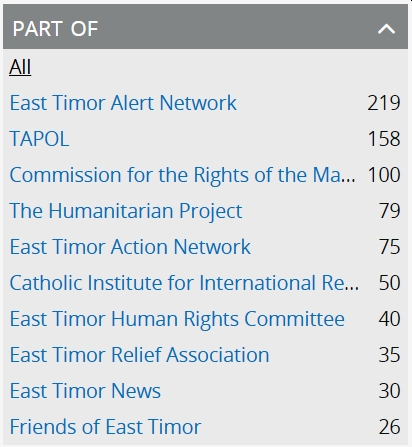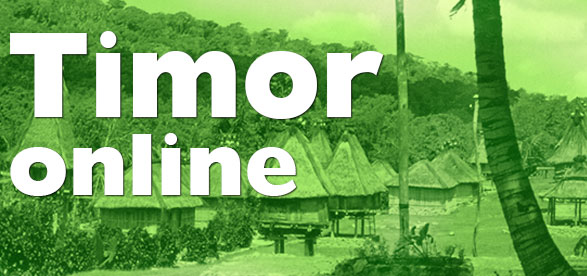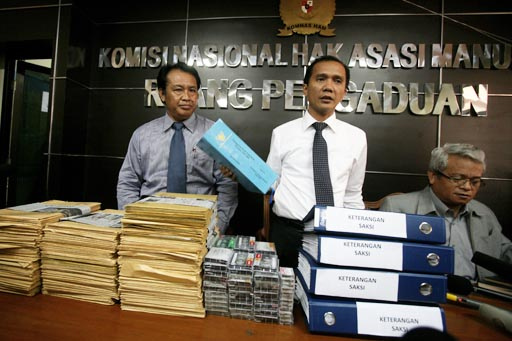There are now several online collections of Timor-Leste archival records for the years 1974-1999. We introduce here the most recent of the resources, David Webster’s Timor International Solidarity Archive. While still developing, it promises to be a ‘go-to’ platform for placing and accessing worldwide archives on Timor and an example for Timor-Leste archival institutions.

The Timor International Solidarity Archive (TiSA) provides online access to digital copies of Timor solidarity movement records, 1975-1999. TiSA is the initiative of the Canadian Timor activist and academic historian, David Webster.
TiSA is the first collection of Timor archives to be delivered online using an archives-specific database system. (1) As the database grows, it will be a useful example for Timor-Leste’s developing archival institutions as they consider collection management and online access systems.

Top ten collections by numbers of digitised items online.
Contents
Currently the database lists over 60 international solidarity groups and individuals who created Timor materials in the occupation years. The majority of groups represented to date are from various European countries, north America and Australia.
There are currently about a thousand items listed in 34 collections, most of which include digital copies. An ‘item’ can be a single document, such as a letter or photograph, or can contain many separate documents.
Within each collection, the items are generally arranged into one or more ‘series’ or groups: Documents, publications, photographs, newsletters and newspaper clippings. TiSA especially has a strong and growing online collection of solidarity newsletters.
The digital copies are currently restricted to documents and photographs. Documentary materials are delivered in PDF format; some of them are text searchable. The copies are created through scanning or direct photography. The quality of some of the photographed items is at the lower-end, but entirely sufficient.
Some Highlights
TiSA has a strong record set from the Canadian ETAN (East Timor Alert Network) and 1990s news compilations from the USA’s ETAN (East Timor Action Network). Less well-known to the post Santa-Cruz Massacre generation of activists is the Timor work of early US activists such as Michael Chamberlain and Arnold Kohen.
One surprising entry in TiSA is the Asian-African Conference Bulletin, published by Indonesia’s Department of Foreign Affairs in 1955, reporting in English on the historic Bandung Conference of non-aligned countries. While containing no Timor content, it is included for research on decolonisation.
Navigating and Searching
Any exploration of archives databases is made easier if users understand the different ‘levels‘ of archival description. TiSA uses the most common basic archival hierarchy: Collection > Series > File > Item. This means that a given collection is made up of a number of groups (‘Series’). Each Series contains one or more ‘Files’ and each File can contain one or more ‘Items’. Every entry in TiSA includes information about its place in that hierarchy.
The opening TiSA screen invites browsing in a number of ways, the top three ways being ‘archival descriptions’ (data on all description levels), ‘collections’ (actually provides the names of ‘creators’ (2)) and archival institutions (where the original archives are held). This is a good way to get a feel for the range of material in the database.
A simple search box at the top of the TiSA screen will find a search term wherever that term is in the database. As the database grows, this method may produce too many results for certain common terms. Generally, we find it is well worth the time to learn to use the advanced search screen to help keep search results more specific.
CHART comments
TiSA has the potential to set the standard for present and future online access to Timor archives. Its value will be greatly enhanced by contributions of material from solidarity groups around the world. Some CHART-created materials are accessible through TiSA; more contributions to come in the near future.
From an end-user point of view, TiSA might be improved by development of a front page which includes the best aspects of the browse function and the advanced search screen. Missing from TiSA, and all but one of the available online databases, is a set of subject headings to use in searches. (3)
In the meantime, it might be useful for end-users to be provided with a basic online guide to the structure of the data and methods for browsing and searching. The search results will be further enhanced by ensuring that key data elements like description levels and creators are consistently entered into the database.
With the exception of the Max Stahl Audiovisual Archive with its highly specialised database, Timor-Leste archives do not yet appear to have adopted archives-specific systems to manage and provide access to their collections. At least one Timor-Leste archival institution is seeing TiSA as a potential model for its own archives management system. We hope other institutions will follow this example.
[See also a Tetum-language version of this article]
Notes
(1) Access to Memory (AtoM) is an open-source free-to-download database system started by the International Council of Archives (ICA) to encourage the use of archival description procedures in small-to-medium size institutions. It is currently being maintained and improved by a Canadian company, Artefactual Systems. AtoM is used in a wide range of institutions internationally – especially in English and Portuguese-speaking countries.
(2) This ‘problem’ is too complicated to discuss here. Suffice to say, we would expect a Browse option called ‘Collections’ to list data with that particular ‘level’ of description. ‘Creator’ is not a level of description, it is a so-called ‘authority record’ (names of people, organisations etc) which can be linked to archival descriptions of any level.
(3) See brief discussion of subject headings in CHART’s 2013 article about CIDAC’s Timor Online resource.
Acknowledgement: CHART provided some early guidance on the development of TiSA. Many thanks to David Webster for the opportunity and for permissions to ‘look behind the scenes’ at the TiSA/AtoM setup.



 Posted by timorarchives
Posted by timorarchives 







![Indonesian leftists being herded off to public execution. [Source: Unknown]](https://timorarchives.info/wp-content/uploads/2013/02/korban1r.jpg?w=450)

![Shared experience: Indonesians and East Timorese. [CHART]](https://timorarchives.info/wp-content/uploads/2013/02/chart-slide.jpg?w=450)
